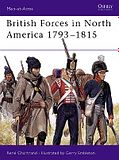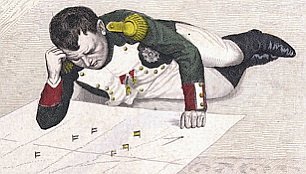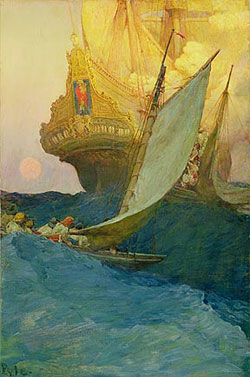
The French fleet heading out to sea
We had a games day at Chez Kinch last week. Donogh brought Force on Force, Admiral Creanor brought the
Fletcher Pratt naval wargame while the chaps gave my latest scenario a run over. In between all of this, I ran from room to room clutching
Noli Illigitemos - a naval kreigspiel written by Paddy Griffith.
Donogh's game was a series of small engagements in Ngorno Karabakh (I think that is how it is spelled) which went rather well, but which he will chronicle on his own blog. Admiral Creanor's Fletcher Pratt game which was a sort of reverse River Plate went well, though apparently ship identification was an issue.
Noli ran well though I regret to say it was a bad campaign for the Royal Navy. They were dogged by ill luck and an uncharacteristically decisive French command.
The wind naturally played a key part in proceedings with the French unwilling to sally until they were assured of a favourable wind. The main events were as follows
- the British fleet was concerned with keeping the French bottled in Toulon and also wanted to prevent an invasion of Corsica.
- the French were to retake Corsica and support French armies in Italy as well as helping boot the Dons out of Perpingnon. This rather tall order was followed by a series of orders-counter orders and threats from Paris as the game progressed.

Toulon
The British began the campaign by instituting a close blockade of Toulon with a skeleton force while maintaining a looser blockade over the horizon. A frigate each was despatched to the Italian and Spanish fronts to raise hell along the coast line. Meanwhile a small squadron covered Corsica and a single frigate was sent too woo the Tuscan rulers of Elba.
The French waited a while until the wind allowed them to venture out, covered by an early morning fog. This gave them the opportunity to engage the close blockade before they could be supported. The French headed for open sea hotly pursued by the British who lost them during the night.
The British admirals were faced with a dilemma, whether to head for Corsica or whether to comb the open sea looking for the Fench. They adopted a compromise plan while the French looped south and headed back to Toulon.
The British reorganised their fleet swiftly, despatching Nelson to circumnavigate Corsica at the head of a strong squadron, while the damaged vessels from the close blockading squadron were sent to Port Mahon for repairs. Meanwhile two sail from the Neapolitan navy had arrived and were kept at Corsica, while Nelson swept east in search of the elusive French. A British frigate was sent into Toulon to get a close look at what if anything was there. The British began to get rather worried when it did not return.
The French on the other hand were of the opinion that an invasion of Corsica would be a very dicey proposition as they only had vessels to transport a quarter of the army. A successful invasion would involve loading soldiers on men of war, a forgiving wind and ensuring that the Royal Navy could be kept off the vulnerable transports.

The French engage the Close Blockading Squadron
Sadly the French admirals arrived home in Toulon (pausing only to beat up the reduced blockading squadron) to outraged letters from Paris condemning their inaction and the demanding that something about the British fleet (actually a frigate) rampaging around the coast of Perpingnon. The French licked their wounds as best they could and waited for a good wind. They then broke out again, abandoning any hope of taking Corsica and setting out to put down the British fleet which was terrorising the French army's supply lines at Perpingnon.
The British meanwhile, were frantically attempting to recall Nelson who had gone as far a field as Alexandria looking for the French. They also set out to find the French fleet and they managed to do so, but not before the French fleet had pummelled the solitary British frigate which had put in a very respectable innings up until now. The British players looked at the balance of forces and felt that as they were outnumbered two to one in ships of the line, it would be madness to attempt to engage the French. They flew back to Toulon with the French fleet in hot pursuit.
Meanwhile a British frigate had finally caught up with Nelson who was making best speed back to Toulon, however battle was joined before he arrived and the French fleet managed to maul the British before being mauled in their turn. The battle ended in a pyrrhic British victory, with seven French vessels being forced to strike. However, the British flag ship was literally shot to pieces and sunk. Surprisingly the British admiral survived this and was taken off on one of the 74s.

The Battle of Toulon
However four Royal Navy ships were forced to strike and two of those were not recaptured. Not the sort of crushing victory the British public are used to and likely to end the careers of the admirals responsible.
In conclusion, this was an enjoyable game and if my poor brain felt a little overloaded, I think I managed to keep all the balls in air without the players seeing behind the curtain too much. The Royal Navy were dogged by poor luck throughout, while the French were uncharacteristically decisive and lucky to avoid the poor weather that would have sunk some of their poorer sailors.
Highlights of the game
- The dashed poor luck of the Frigate Excelsior, dis-masted by a lucky shot in Toulon harbour and taken.
- The problems of the British command, many times they echoed Nelson's claim that if they were to die, "want of frigates" would be written on their hearts.
- The instant response by the French to political pressure from Paris which led them on a strategic wild goose chase to Perpignon.
- The drastic over estimation of the raiding effectiveness of the British frigates.
- The pluck of the Luigi, a 74 of the Neapolitan navy, which fought every gun to the last an the battle of Toulon, standing where better crewed, better trained and better built ships either struck or were sent to the bottom. They were definately proof of General Du Gormand's diction, "better lucky than good."
Definately a game I would run again.
























































